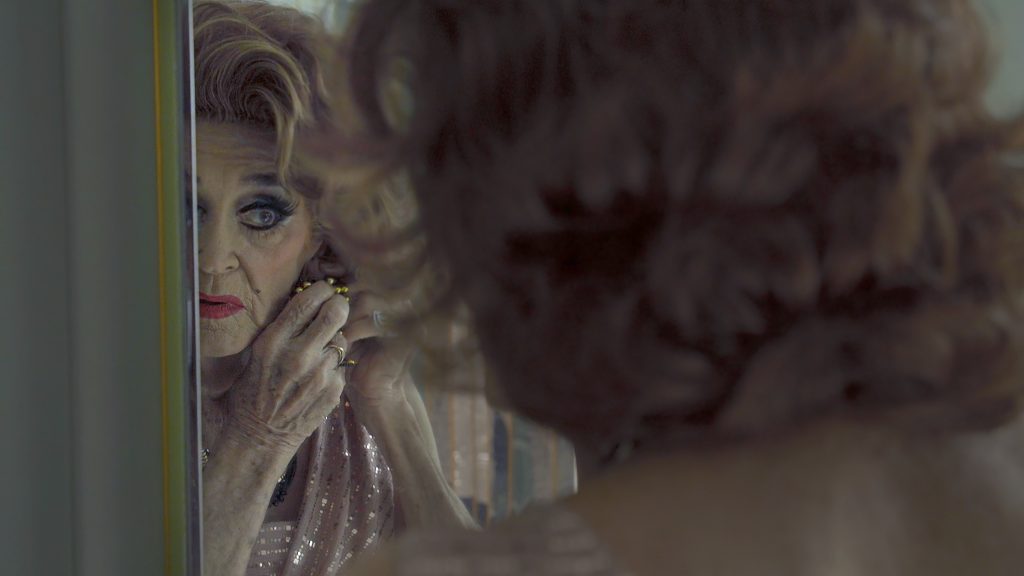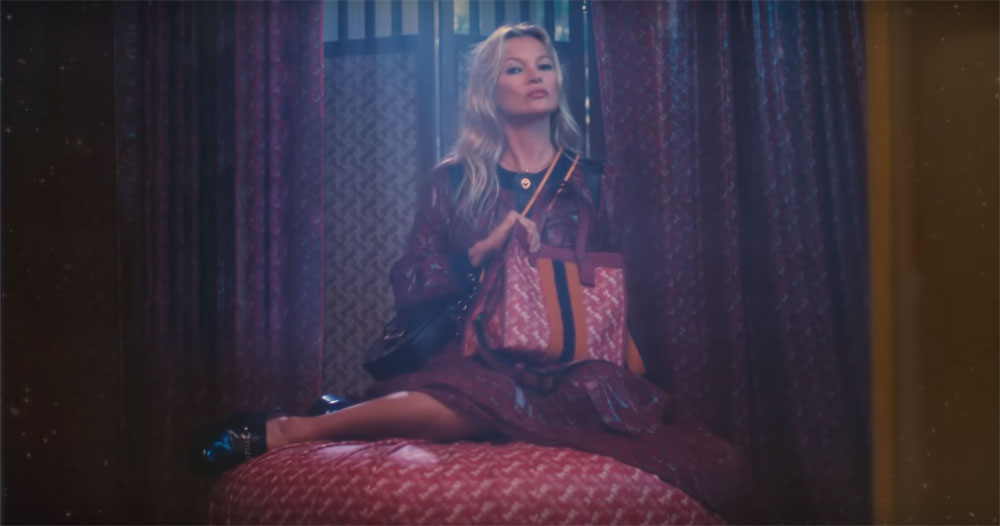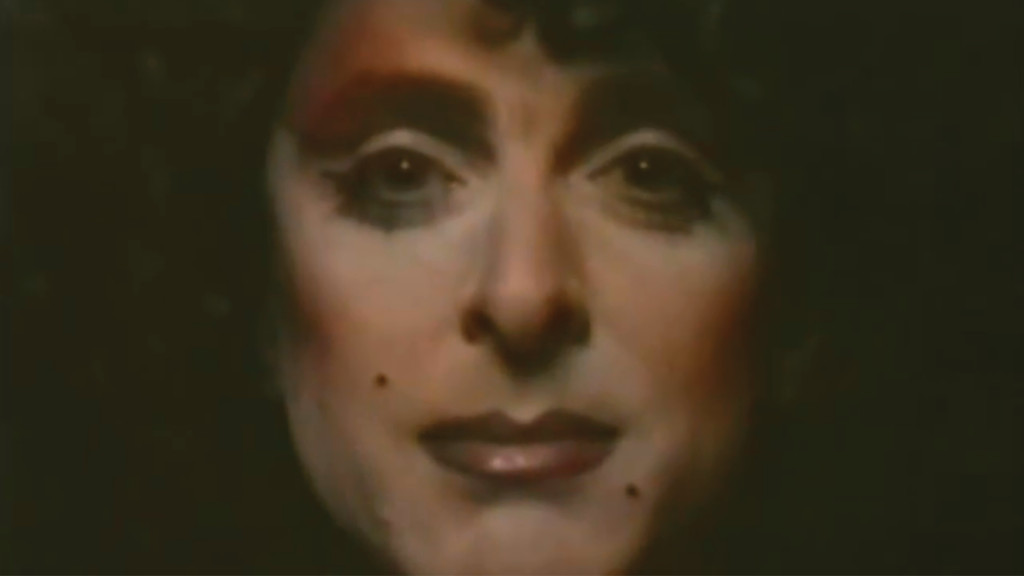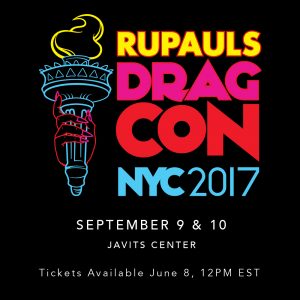June 11, 2022
by Carla Hay
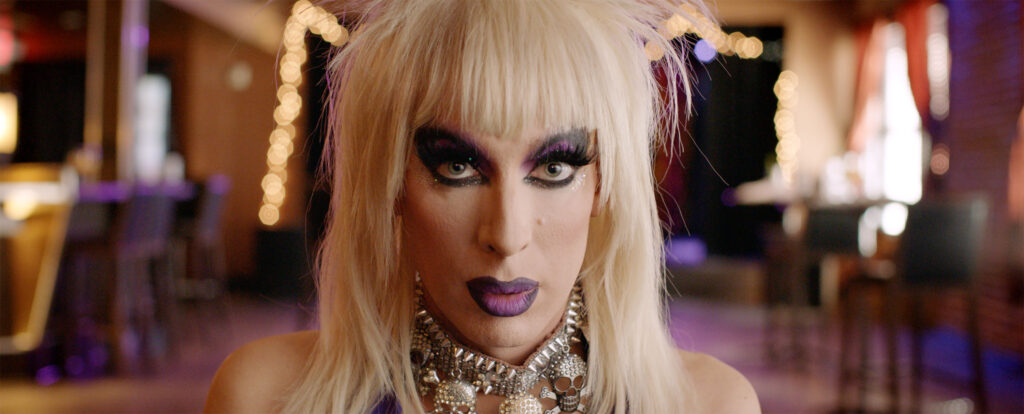
“God Save the Queens” (2022)
Directed by Jordan Danger
Culture Representation: Taking place in California’s Los Angeles County, the comedy/drama film “God Save the Queens” features a predominantly white cast of characters (with some African Americans, Latinos and Asians) representing the working-class and middle-class, and who are connected in some way to drag queen culture.
Culture Clash: Four drag queens find themselves at the same group retreat, where they share their stories about their personal struggles and career problems.
Culture Audience: “God Save the Queens” will appeal primarily to people who are interested in drag queen culture and stories about people who aren’t afraid to be themselves in a world that doesn’t always accept them.
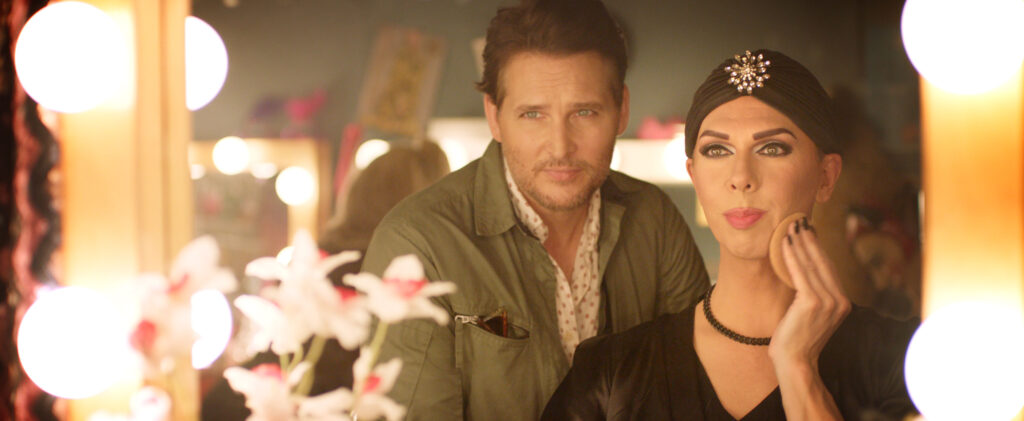
“God Save the Queens” has the right blend of spicy and sweet comedy mixed with sentimental drama in this unique story about four drag queens in group therapy at a retreat. Some of the acting is uneven, but this independent film has a scrappy spirit that’s irresistible. There’s plenty of divalicious dialogue and engaging characters that should please fans of entertainment where drag queens are celebrated and not exploited. “God Save the Queens” had its world premiere at the 2022 Tribeca Film Festival in New York City.
Written and directed by Jordan Danger, “God Save the Queens” is her feature-film directorial debut, after she has spent years in the entertainment business as an actress. One of the best things about the movie is that the characters (main and supporting) are written with distinct personalities. “God Save the Queens” (which is set in California’s Los Angeles County) is not the type of movie where viewers will have a hard time remembering the characters or telling the characters apart. Almost all of the drag queens in the movie are played by real-life drag queens.
Most scripted feature films about drag queens tend to make the end goal a big performance or contest that takes place near the end of the story. “God Save the Queens” features snippets of performances, but the movie’s main focus is on what the four main drag queen characters reveal about themselves when they end up together in group therapy sessions during a retreat in California’s Topanga Canyon. The movie also doesn’t play into the drag queen movie/TV stereotype of a bunch of drag queens going on a road trip together and getting various reactions when they show up in places that aren’t used to seeing drag queens.
As an example of how musical performances are not the main focus of the movie, “God Save the Queens” shows the drag queen performers on stage in montage sequences without the movie’s soundtrack playing the music that the queens are supposed to be performing. It could be because the movie’s budget didn’t allow for well-known songs to be licensed for the film, but it feels like the right choice to have a lack of karaoke-type scenes, since the story is about more about how these drag queens deal with life off stage rather than showcasing what they do on stage. The only viewers who might be disappointed in this filmmaker choice are people who might be expecting “God Save the Queens” to be like “RuPaul’s Drag Race.”
The movie does a good job of introducing the main characters before they find themselves baring their souls in this retreat. All of them have their individual quirks that make them relatable to viewers. The four drag queens at the center of the story are:
- GiGi (played by Jordan Michael Green), whose real name is Klein Carter, is a drag queen singer who is trying to make a name in the entertainment industry. Klein lives in a shabby, working-class house with his adoptive single mother Eloise (played by Ellen Gerstein), who is loving and completely supportive of who Klein is. Klein, who is a combination of confident and vulnerable, has a tendency to give pep talks to himself out loud when he looks in a mirror or window. One of his biggest celebrity idols is a Los Angeles-based charismatic female pop star named Harlowe (played by Kimberley Crossman), who is an immigrant from New Zealand.
- Marmalade (played by Kelly Mantle), whose real name is Lewis, is a drag queen stand-up comedian and the oldest of the four queens. (Marmalade is in her 40s, while the other three queens are in their 30s.) While Klein worries about being a “never-was,” Lewis worries about being a “has-been.” In his cluttered home, where he lives alone, Lewis (who started doing drag at age 19) keeps mementos of when he won drag queen contests when he was in his 20s. Lewis is very feisty and doesn’t hesitate to cut people down with blistering comments if they do or say things that annoy him. Lewis shows a softer side to himself when he talks to his beloved pet parakeet LoToya.
- Stevie Dix (played by Alaska Thunderfuck), whose real name is never mentioned in the movie, is a drag queen singer who is very sassy and who places a high value on honesty and loyalty. That’s why Stevie is still very hurt over how his longtime friendship ended with someone who was his best friend and partner in a musical duo act called Dix Royale. Stevie is trying to launch a career as a solo act, but is finding it harder than he expected.
- Rita (played by Laganja Estranja), whose real name is also never mentioned in the movie, is a drag queen singer who was Stevie’s best friend and partner in Dix Royale. The two pals had a falling out over a man named Carlos. Rita confided in Stevie about having a crush on Carlos, but Rita believes that Stevie seduced Carlos (played by Francis Gonzalez), who makes a brief appearance later in the movie. Rita, who is extremely vain, likes to think she’s always the most beautiful drag queen in any room, but Rita is not so self-centered that she doesn’t have room in her heart to give and receive love.
An early scene in the movie shows that Klein is struggling to find work. He goes to interview for a home care job where he would be taking care of an elderly man. The man’s wife Esther (played by Judith Scarpone), who interviews Klein for the job, shows her prejudice when she rudely rejects Klein and tells him to immediately leave after she sees that he’s wearing nail polish. As revenge, Klein steals a small gold elephant figurine on his way out the door, and then he gives the figurine to Eloise as a gift.
Later, it’s shown that Klein’s financial woes lead him to take an offer he can’t refuse from a friend named Olive (played by Thomas Ochoa), who’s also a drag queen. Olive offers to give Klein some money and to do the marketing for an upcoming live performance by Klein’s drag persona GiGi. Things don’t go exactly as planned.
Meanwhile, Lewis/Marmalade works at a drag queen club called the Starlight Lounge, which is owned and managed by a straight guy named Simon (played by Peter Facinelli), who thinks Marmalade is the best performer at the club. Simon privately gives this compliment to Marmalade in a scene that takes place in the club’s dressing room. Other drag queens who work at the Starlight Lounge include Layla (played by Ingenue), Penny Pinch (played by Vicky Vox) and Augusta Wind (played by Jp Moraga), with Layla as Lewis/Marmalade’s closest friend.
Lewis/Marmalade also has a big admirer: a neighbor in his early 20s named Tyler (played by Denny McAuliffe), who introduces himself to Lewis one day when Lewis is about to get a car ride with Layla to go to the Starlight Lounge. Tyler, who calls himself a “drag enthusiast,” tells Lewis that he saw a torn drag outfit in Lewis’ garbage, so Tyler eagerly offers to mend the outfit and to do Tyler’s makeup. Lewis, who isn’t sure if Tyler is a stalker type, is rather standoffish and impolite in telling Tyler that he doesn’t need any help, and demanding that Tyler should only call him Lewis (not Marmalade) when Lewis is not in drag.
Stevie and Rita are now solo acts at the Plastic Pancake Palace, which is a more downscale and smaller venue, compared to the Starlight Lounge. The manager of the Plastic Pancake Palace is a butch lesbian named Charlie (played by Julie Goldman), who thinks that Stevie and Rita are better as a duo than as solo acts. Another person who feels the same way is Dix Royale’s biggest fan: a loyal customer named Nolan (played by Zack Gottsagen), who happens to have Down syndrome.
Nolan and Charlie aren’t the only ones who think that Dix Royale should get back together. Two slick executive producers of a drag queen TV talent contest called “Talent’s a Drag” show up at the Plastic Pancake Palace. Their names are Hugo (played by Joaquim de Almeida) and his son Hugo Jr. (played by Lourenço de Almeida), who tell Stevie and Rita that they want Stevie and Rita to be on the show, on the condition that Stevie and Rita perform on the show as Dix Royale.
The other condition is that Stevie and Rita need to go to therapy together at a retreat before they can be on the show. Stevie and Rita are barely on speaking terms and don’t like the idea of working together again. But the opportunity to be on this show is too good to pass up, so Rita and Stevie reluctantly agree to these conditions. Charlie warns Stevie and Rita that Hugo has a reputation for sexually harassing drag queens on the show. This reputation is something that is brought up later in the story.
It’s unclear how Klein and Lewis ended up on the retreat, but all four of the men are in the same group therapy sessions together. They talk about their lives and recent pivotal moments during multiple sessions. At first, the therapy sessions are led by a hippie couple named Guy (played by Jonathan Goldstein) and Gail (played by Rachelle Carson-Begley), who talk in a lot of New Age-type babble that isn’t very helpful.
One day, someone else (played by Luenell) is there as a substitute for Guy and Gail. (This session leader’s mystery identity is revealed at the end of the movie.) Once this sarcastic individual leads the group sessions, the four men start to open up more and have some breakthroughs. A recurring joke in these sessions is that every time Lewis starts to tell his story, he can’t finish it because the session then ends for the day.
“God Save the Queens” has some biting commentary about drag queen reality TV shows and contests that are operated by people who care mostly about causing conflicts between the drag queens and don’t really care about the drag queens as people. “God Save the Queens” director Danger has a satirical cameo as a “Talent’s a Drag” producer named Scheana, who embodies this type of showbiz callousness that’s disguised with fake smiles and pretending to be friendly with people who are exploited on reality shows.
And speaking of drag queen reality shows, “RuPaul’s Drag Race” judge/senior producer Michelle Visage has a memorable supporting role in “God Save the Queens” as a haughty talent scout named Liv, who shows up at the Starlight Lounge. Liv’s presence leads to what is probably the movie’s highlight that involves a big moment for Lewis/Marmalade. It’s one of the reasons why Mantle gives a scene-stealing performance throughout this movie.
Many movies about the LGBTQ community, even the comedies, have homophobic violence or other hate crimes as part of the story. People who are a little tired of seeing that narrative in LGBTQ movies will be delighted to know that there’s no violence in “God Save the Queens,” although the movie does responsibly show how homophobia is hurtful. Klein (who is African American) also talks about and experiences some racism.
“God Save the Queens” should also be commended from not trying to put an unrealisitc and glossy spin on the lives of drag queens, especially those who are considered on the margins of society and the ones who might never be seen on a mainstream show like “RuPaul’s Drag Race.” The movie depicts the financial realities of struggling entertainers, who often have to live with parents or in small dwellings. (For example, Rita lives in a small trailer.) It’s particularly true in large metropolitan areas such as Los Angeles County, where the cost of living is much higher than in other places in the United States.
“God Save the Queens” has moments where the movie’s acting, dialogue and pacing don’t flow as smoothly as they could. However, the movie has immensely charismatic cast members who make even the questionable parts of the movie watchable. You can tell that many of the cast members have lived the experiences depicted in the movie, which make their performances much more authentic than if they had been played by well-known Hollywood actors.
Estranja (whose real name is Jay Jackson) and Thunderfuck (whose real name is Justin Andrew Honard) are utterly believable as bickering queens Rita and Stevie. They have to deal with issues of jealousy and rivalry not only as friends but also as entertainment duo partners who are now working together again. The ups and downs of Stevie and Rita’s relationship will tug at viewers’ emotions, especially when it’s revealed that Rita and Stevie have been each other’s only family, because their biological families have rejected Rita and Stevie for being gay.
Green’s performance as Klein/GiGi is perfectly fine, but sometimes comes across as forced and hammy, as if he’s is playing a stereotype. Still, Klein seems to be self-aware that he’s kind of an oddball who talks out loud to himself, when he’s shown in a scene looking in his bedroom mirror and saying out loud, “And for fuck’s sake, stop with the monologues! Who are you? Carrie Bradshaw?” (Fans of “Sex and the City” will understand that joke.)
“God Save the Queens” is a cheeky title whose meaning is made clear by the end of the movie. The story happens to be about drag queens, but it speaks to larger issues that anyone can relate to about finding one’s identify, self-acceptance and a support system in good times and bad times. As pure entertainment, “God Save the Queens” has plenty of laugh-out-loud moments and some meaningful drama that should make this movie something that a lot of viewers will want to watch again.


